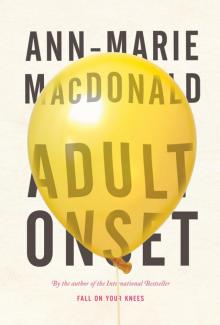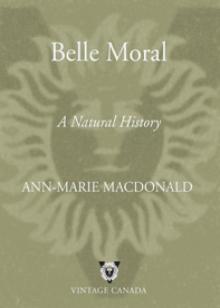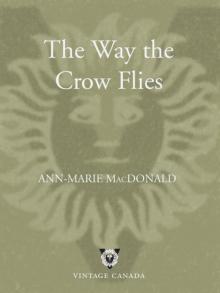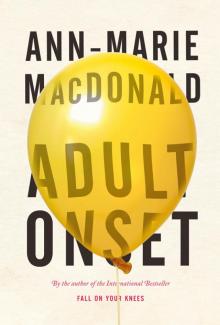- Home
- Ann-Marie MacDonald
Belle Moral: A Natural History
Belle Moral: A Natural History Read online
VINTAGE CANADA EDITION, 2008
Copyright © 2005 A. M. MacDonald Holdings Inc.
All rights reserved under International and Pan-American Copyright Conventions. No part of this book may be reproduced in any form or by any electronic or mechanical means, including information storage and retrieval systems, without permission in writing from the publisher, except by a reviewer, who may quote brief passages in a review.
Published in Canada by Vintage Canada, a division of Random House of Canada Limited, Toronto, in 2008. Distributed by Random House of Canada Limited, Toronto.
Vintage Canada and colophon are registered trademarks of Random House of Canada Limited.
www.randomhouse.ca
CAUTION: Professionals and amateurs are hereby warned that BELLE MORAL is subject to a royalty. It is fully protected under the copyright laws of the United States, Canada, United Kingdom, and all British Commonwealth countries, and of all countries covered by the International Copyright Union, the Pan-American Copyright Convention, and the Universal Copyright Convention. All performance rights, including professional, amateur, motion picture, recitation, public reading, radio broadcasting, television, video or sound taping, all other forms of mechanical or electronic reproduction, such as information storage and retrieval systems and photocopying, and rights of translation into foreign languages, are strictly reserved.
Inquiries concerning the performance rights should be directed as follows: Lorraine Wells and Company Talent Management Inc., 10 St. Mary Street, Suite 320, Toronto, Ontario M4Y 1P9, (416) 413-1676/fax (416) 413-1680.
LIBRARY AND ARCHIVES CANADA CATALOGUING IN PUBLICATION
MacDonald, Ann-Marie
Belle moral / Ann-Marie MacDonald.
A play.
eISBN: 978-0-307-36991-8
I. Title.
PS8575.D38B45 2008 C812′.54 C2007-906941-X
v3.1
La Fin de Siècle and
the Pull of Opposites
by Kathleen Gallagher
“What is objectivity but the ability to consider every influence on our powers of observation? Facts, uprooted, can tell us only so much. A fact out of context is like a fish on a slab, inexplicable without water.” And so it is the story, an “inextricable web of affinities,” said Darwin, and not disembodied facts, that Ann-Marie MacDonald draws us into. In our journey to the coast of Scotland, 1899, she asks us to remember our own childhoods, our dreams and ghosts and hauntings, our apprehension of a world that calls on all of our senses. She asks us to observe our lives, our part in evolution. “We are all here so briefly,” says Pearl. “Awake, for a moment. Unique, for a moment. Able to look and to love, for a moment.”
Theatre, unlike literature, is a social art form and so it is important that we are here together to participate – to see, hear, smell the stories percolating deep inside the stone walls, hidden attic, and candle-lit drawing room of Belle Moral. Five miles outside Edinburgh, itself a haunted city with phantom pipers and memories of murder, we are thrust into the present lives and troubling histories of the MacIsaac family.
Everywhere we turn, there is the pull of opposites: science versus nature, rational versus supernatural, past and present, conscious and unconscious, public and private, truths and lies, Protestant and Catholic, normal or deviant, highland versus lowland, drunk or abstemious, French or English, masculine and feminine, tragedy and comedy. Belle Moral is, in some ways, a meditation on these and other great themes of human preoccupation.
Historically, Scotland has been a place of just such contradictions. It is a land of legends, first whispered by fairies: crashing waves of the North Sea, twisting roads lined with stone, mist-covered mountains and sounds of distant pipes, flutes, harps, and wailing banshees; stories of monsters who live alongside the mortals that inhabit the small country. And in this world of fairies and hideous creatures, we have science’s search for truth. After the last battle for its independence from English rule in the spring of 1746, the undaunted spirit, the pride and deep curiosity of a people earned Scotland and the Scottish Enlightenment its glorious reputation in the story of the modern world and its advancement of human understanding. A recent book, How the Scots Invented the Modern World (2001), even argues that the great Scottish scientists and inventors of the second half of the nineteenth century – Watt, Telford, Nasmyth-were largely responsible for the building and organization of the British empire.
Beneath the rugged beauty of the coast and Scotland’s scientific genesis, we have the story of Pearl MacIsaac, a budding scientist in her own right. The biological determinism and moralism of social Darwinism, however, saw the emancipation of women as an attack on patriarchal culture and the “natural” way of the world. These rebellious daughters were swiftly labelled mentally disturbed or suffering from “nerves”. In her book The Female Malady (1985), Elaine Showalter points out that Jean-Martin Charcot, one of the first European theorists of the female disease that came to be known as hysteria, believed that hysterics suffered from a hereditary taint that weakened the nervous system. The ovarian region, he concluded, was a particularly sensitive “hysterogenic zone”. In addition, he developed a theory suggesting that hysteria also had psychological origins. As such theories of biological sexual difference were given full scientific weight, the Victorian ideals of femininity tightened their grip.
Sigmund Freud, however, began to recognize the social and cultural constraints on women, and with his colleague Josef Breuer produced their Studies on Hysteria in 1895. This work presented a much more sympathetic view, maintaining that hysterics were not insane, but “people of the clearest intellect, strongest will, greatest character, and highest critical power”. Freud and Breuer’s case studies stood in contrast to many of the hostile portraits of hysterical females presented by European physicians of the Victorian period. At Belle Moral, however, it is brother Victor’s lust for life that most effectively unsettles the gender codes. “Victor is morbidly effeminate,” claims Pearl, but Victor is the artist, the female subject position, and not the effeminate. He is the one who seduces us into the struggle against repression. “The artist is the one who refuses initiation through education into the existing order,” offered Norman O. Brown in a 1959 study of Freud’s work. Hence the dialectical interplay, in the play, between the extreme Rationalism of Dr Reid, who believes that insanity can be avoided by a life of moderation and the exercise of the will, and the ideals of those like Victor the Romantic, more drawn to the willing suspension of common sense.
While “lunatics” of the fin de siècle often fell silent or succumbed to paralytic seizures, Victor concocts a rich dream-life as an outlet for his spirit and a clear, sobering philosophy by which to live. Dreams, or wish-fulfillment, are the work of the unconscious, argued Freud, at a time when his contemporaries had little appreciation for such things that could not be properly measured. Both Pearl and Victor are immersed in the life of the imagination, which opens up other worlds. These “other worlds,” it might be said, underlie our “normal” experience, and for both Pearl and Victor there is a dangerous yet desirable attraction to the irration al, the seemingly abnormal. Playwright MacDonald believes that “consciousness and dreams form a compound as necessary for life as hydrogen and oxygen.”
If Freud was right in suggesting that our dreams, our humour, and slips of the tongue explain in some way our mental states, and reveal in covert form what would otherwise not be understood at all, Pearl may well be on the cusp of discovering what was always there, morally inescapable but unarticulated: Darwin’s “inextricable web of affinities”. While Dr Reid might be playing God with his presumptuous science, Pearl’s love illuminates the important questions: “And what
are we to do in God’s place? How are we to know what God’s work is?”
Ann-Marie MacDonald has been interested in alchemical transformations, the unconscious, and the fantasies of gender play since such earlier works as Goodnight Desdemona (Good Morning Juliet) and Anything That Moves. These are narrative interests we have seen before. But in Belle Moral, the world of the senses and sense perception also drive these narrative tropes. We have Auntie Flora who believes in the communication of spirits (“Your ancestors are tryin’ to tell you something”) and Puppy with the canine sense, more acute than that of humans and more sensitive to the supernatural presence.
But what or who will be transformed this time? How does history get mapped onto the pre sent? Where might our unconscious lead us in our pursuits of truth? How do our ancestors talk to us? Do we admit to our connection in diversity, to our common ancestry, to being a part of that “exquisitely, well-nigh infinitely complex web?” Darwin himself explained:
Analogy would lead me one step further, namely, to the belief that all animals and plants have descended from some one prototype … Therefore, I should infer from analogy that probably all the organic beings which have ever lived on this earth, have descended from some one primordial form, into which life was first breathed.
Perhaps it is no surprise that Ann-Marie MacDonald would tell a truly postmodern tale set at the height of the great project of modernity, for paradox is her centerpiece, while story is her form:
PEARL. Doctor, you look at us and see a jumble of unrelated, distasteful facts. I look and see affinities.
VICTOR. A story.
PEARL. That’s right. A plot.
Deeply implicated in our own histories of family and culture, MacDonald takes the socially “natural” configuration of family and paradoxically asks how sure we can ever be of the constitution of family. If it is the case that “we are free agents as well as products of history, accidental and inevitable, like the best stories,” then family can be imagined and can further set our psychic apparatus in motion, as in a wish. Our roots/routes to family are multiple.
Pulled, as always, by the reconciliation of opposites, Ann-Marie MacDonald has an unquenchable fascination with puzzles and a certain penchant for the comic turn:
PEARL. I don’t believe in ghosts.
FLORA. That’s of nay concern to the ghosts.
Seeking to regain the lost laughter of childhood, she can rarely resist a pun or the opportunity to find the playful in the serious, especially, she explains, when she writes for the theatre. In an interview published in 2003, MacDonald describes what she does as driven by a “love of the audience” and a “love of performing:”
I found a great intellectual hunger and curiosity, combined with a love of stories and a love of the fabulous … I want to give the audience a reason to stay, give them a reason to want to find out more and to want to identify with different points of view, different experiences. For me, that’s my hardcore passion: put yourself in someone else’s shoes.
As we move into the final scenes of Belle Moral, MacDonald’s love of the fabulous is in full force; the secrets, laid bare. For lies never protect us, as poor Dr Reid must learn. “Knowledge is power,” said Sir Francis Bacon in the sixteenth century, and this became a slogan of the Enlightenment midway between his time and our own. Since then, the closet doors have burst open … tant mieux! We need to know our stories and let the ghosts out.
Kathleen Gallagher is Associate Professor and holds a Canada Research Chair at the Ontario Institute for Studies in Education, University of Toronto (OISE/UT). She has published many articles on drama, education, and the sociology of arts, and her book Drama Education in the Lives of Girls: Imagining Possibilities (2000) received the American Education Research Association’s book award for significant contribution to Curriculum Studies. Her edited collection How Theatre Educates: Convergences and Counterpoints with Artists, Scholars, and Advocates, (2003) argues for a broader understanding and definition of theatre as an educative force.
For Zsa Zsa
Contents
Cover
Title Page
Copyright
Dedication
ACT I
ACT II
ACT III
Afterword: by Ann-Marie MacDonald
BELLE MORAL
A Natural History
Dramatis Personae
THE BRIDE
THE JACKAL
PEARL MACISAAC, thirty-two, an amateur scientist
FLORA MACISAAC, a lady in her late fifties / early sixties
VICTOR MACISAAC, Pearl’s younger brother, twenty-seven
YOUNG FARLEIGH, an elderly servant
DR SEAMUS REID, a gentleman in his late fifties / early sixties
PUPPY, a black dog with a flat head for patting
MR ABBOTT, a solicitor in his thirties
WEE FARLEIGH, a young and handsome servant
THE CREATURE
CLAIRE, a young woman
The action takes place in spring and summer 1899 on the coast of Scotland, a few miles outside Edinburgh, in a large old stone house called Belle Moral.
The Arab’s Mouth, an earlier version of this play, premiered at the Factory Theatre, Toronto, in the fall of 1990, with the following cast:
Pearl MARTHA BURNS
Ramsay / Anubis /
Mr Abbott DEREK BOYES
Victor HENRY CZERNY
Dr Reid DAVID FOX
Flora PATRICIA HAMILTON
Nun / Puppy / Creature MARTHA ROSS
Directed by MAUREEN WHITE
Designed by SUE LePAGE
Lighting designed by LESLIE WILKINSON
Sound designed by DAVID AKAL JAGGS
Dramaturgy by MAUREEN WHITE
and JACKIE MAXWELL
Stage Manager: MARIA POPOFF
Assistant Director: DEREK BOYES
(The role of Mr Abbott
was cut in subsequent revisions.)
Belle Moral: A Natural History was first performed at the Shaw Festival Theatre, Niagara-on-the-Lake, on July 7, 2005, with the following cast:
Pearl MacIsaac FIONA BYRNE
Flora MacIsaac DONNA BELLEVILLE
Victor MacIsaac JEFF MEADOWS
Young Farleigh BERNARD BEHRENS
Dr Seamus Reid PETER MILLARD
The Jackal /
Wee Farleigh JEFF MADDEN
The Bride / Creature /
Claire JESSICA LOWRY
Mr Abbott GRAEME SOMERVILLE
Directed by ALISA PALMER
Designed by JUDITH BOWDEN
Lighting designed by KEVIN LAMOTTE
Original music composed by PAUL SPORTELLI
Stage management by
Joanna Jurychuk and Christine Oakey
The Playwright would like to extend
her thanks to Paul Birt, Jerry Doiron,
Margaret Gaffney, Jean German, Denis Johnston,
John Hugh MacDonald, Jackie Maxwell,
Nadine McInnis, Alisa Palmer and Maureen White.
ACT I
Scene 1 The Underworld
Night. Sound of the sea. A BRIDE enters, dressed in a flowing white gown, and veil that covers her face. She is searching for something by the light of her candle. Delicate distant melody, “Au Claire de la Lune”. In one corner, lies a faded tartan blanket; sound of an infant crying. THE BRIDE is drawn toward the blanket. Sound of a bagpipe drone. THE BRIDE picks up the blanket, then pauses, sensing the presence behind her: it is a man with the head of a jackal reminiscent of Anubis. There is a formality to his movements. He is neither malevolent nor benevolent, merely a guide, a conductor of souls to the underworld. He claims the blanket from THE BRIDE, and blows out her candle. Ambient female cry, “Pearl!”
Scene 2 Pearl’s Study at Belle Moral
Night. PEARL is sitting bolt upright at her desk, eyes wide, having just awakened from the nightmare. She is dressed in high-collar blouse and neatly tailored tweeds. Her study is a model of Victoria
n polymathic precision: books, fossils, butterfly case, skulls of various species, a telescope, a microscope. Her desk is littered with papers and in one corner of it sits a murky specimen jar. A knocking at the door. PEARL blinks.
FLORA [offstage]. Pearl?
FLORA MACISAAC enters with a lamp, a set of keys at her waist.
PEARL. Auntie Flora?
FLORA. Were you ridin’ the nightmare again, pet?
PEARL [business-like]. Perhaps I was. I don’t remember.
FLORA. You must endeavour to remember, dear. Your ancestors are tryin’ to tell you something.
PEARL. Which ancestors are those, Auntie? The apes or the amoebas?
FLORA. Do go to bed, pet, it’s nigh on three.
PEARL. I can’t, Auntie, I’m working. [crisp and efficient] I intend to submit an article on Cretaceous Caledonian mollusks to the Royal Geological Society in London, and this time I shall sign it, “Percival MacIsaac, Esquire”. See if they dismiss “Percy” with the same alacrity with which they advised “Pearl” to return to more womanly pursuits.
FLORA. What in the Lord’s name is that?
PEARL. The Cretaceous Period, Auntie, a fossil-rich –
FLORA. No, dear. That.
PEARL. Oh, that [picking up the specimen jar]. It is the tufted ear of a clinical idiot, upon which there is a point. Marvelous, isn’t it? Observe the whorls, the delicate lobe, at once so familiar, so … human; jarringly juxtaposed with the unmistakeable bestial peak into which the top of the ear resolves. And the thick growth of what could never be described as mere hair. See? Still glossy, gracefully suspended in sterile solution: fur.
FLORA. Wherever did you obtain such a blasphemy?
PEARL. Dr Reid …
FLORA. Dr Reid?
PEARL. Yes. He very kindly loaned it me when I admired it on the shelf of his laboratory. Dr Reid was quite the budding Darwin in his day, did you know that, Auntie? A pity, he abandoned his research. And what a shame, a specimen like this gathering dust.

 Adult Onset
Adult Onset Belle Moral: A Natural History
Belle Moral: A Natural History The Way the Crow Flies
The Way the Crow Flies SSC (2012) Adult Onset
SSC (2012) Adult Onset